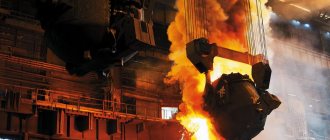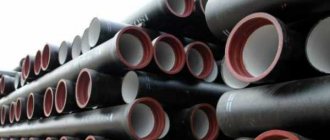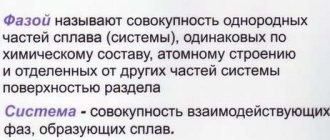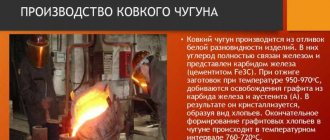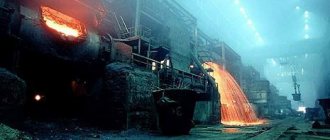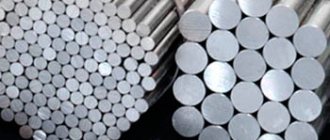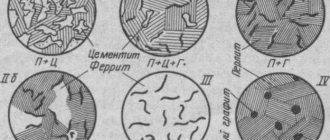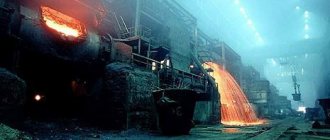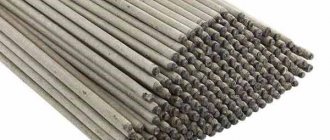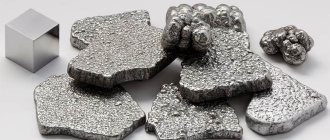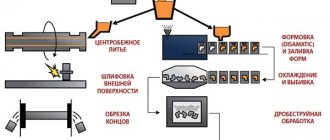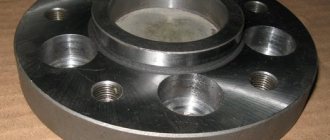General description of cast iron
Depending on the impurities used to melt cast iron, its properties also change. However, there are also those features that must be supported in any case. One of them is the mass fraction of carbon in the composition. This parameter must be no less than 2.14%. If the carbon content is lower, then it is no longer cast iron, but steel. It is important to understand here that ordinary cast iron is not produced as such. In the process of obtaining this material, two types of additives are always added at the end of the operation, according to which the division into foundry or pig iron occurs. One of the features of this raw material is also that the temperature required for its melting is 250-300 degrees higher than for steel. To melt this substance, a temperature of 1200 °C is required.
Features of the steel production process
In the production of cast iron and steel, different technologies are used, despite the fairly similar chemical composition and some physical and mechanical properties. The differences are that steel contains less harmful impurities and carbon, due to which high performance is achieved. During the smelting process, all impurities and excess carbon, which causes an increase in the fragility of the material, go into slag. Steel production technology involves forced oxidation of basic elements due to the interaction of iron with oxygen.
Melting steel in an electric furnace
When considering the production process of carbon and other types of steel, several main stages of the process should be highlighted:
- Rock melting. The raw materials that are used to produce metal are called charge. At this stage, during the oxidation of iron, impurities are also deoxidized. Much attention is paid to reducing the concentration of harmful impurities, which include phosphorus. To ensure the most suitable conditions for the oxidation of harmful impurities, a relatively low temperature is initially maintained. The formation of iron slag occurs by adding iron ore. After the release of harmful impurities on the surface of the alloy, they are removed, and a new portion of calcium oxide is added.
- Boiling of the resulting mass. After the preliminary stage of cleaning the composition, baths of molten metal are heated to a high temperature, and the alloy begins to boil. Due to boiling, the carbon contained in the composition begins to actively oxidize. As previously noted, cast iron differs from steel in having too high a carbon concentration, due to which the material becomes brittle and acquires other properties. This problem can be solved by injecting pure oxygen, due to which the oxidation process will occur at high speed. When boiling, bubbles of carbon monoxide are formed, to which other impurities also adhere, due to which the composition is purified. At this stage of production, sulfur, which is a harmful impurity, is removed from the composition.
- Deoxidation of the composition. On the one hand, adding oxygen to the composition ensures the removal of harmful impurities, on the other hand, it leads to a deterioration in basic performance qualities. That is why, to clean the composition from harmful impurities, diffusion deoxidation is often carried out, which is based on the introduction of a special molten metal. This material contains substances that have approximately the same effect on the molten alloy as oxygen.
In addition, depending on the characteristics of the technology used, two types of materials can be obtained:
- Calm ones who have gone through the deoxidation process to the end.
- Semi-quiet, which have a state between calm and boiling steels.
During the production of the material, pure metals and ferroalloys can be added to the composition. Due to this, alloyed compounds are obtained that have their own specific properties.
How is cast iron obtained?
It’s worth noting right away that the production of pig iron or regular iron is almost identical processes, and therefore it makes no sense to describe both. Let us consider only the general smelting technology.
So, to obtain this substance, you need to spend a large amount of resources. The main working raw materials are coke and water. In order to be able to smelt a ton of pig iron, you need to take approximately 550 kg of coke or about 900 liters of water. It is impossible to determine exactly the amount of ore that will be spent on processing for each batch, since its consumption depends entirely on the percentage of iron content. However, using absolutely any ore is unprofitable if you look at it from an economic point of view. For this reason, raw materials are used that contain 70% iron or more. It is also important to note that before smelting, the ore is enriched, and only after that it enters the blast furnace, where the process of producing cast iron takes place. Electric furnaces melt only 2% of the total amount of material.
Basic information about foundry and pig iron
Cast iron is an iron-carbon alloy with a higher carbon content than steel. It is a primary product used for processing in the production of steel and in secondary smelting in the production of cast iron. The widespread use of cast iron in the engineering industry has been facilitated by its excellent strength properties, so some cast irons are slightly inferior in strength to carbon steel. In modern industry, cast iron products account for about 75% of the total volume of castings. Cast iron is mainly used for steel production, and a smaller part of cast iron (about 20%) is used to obtain cast iron materials for various industries. Cast iron differs from steel not only in composition, but also in technological properties, such as better casting qualities, less plastic deformation and it is cheaper than steel.
It is divided into foundry cast iron, which serves as the main component of the charge in foundry production, and pig iron, which is used for conversion into steel. The main method of producing ferrous metals is the extraction of pig iron from ore and its subsequent processing into steel. The blast furnace production process is a traditional method that involves reducing iron from ore and then carburizing it.
Pig iron is a primary alloy in solid or liquid form, smelted in a blast furnace and processed into steel. It has a low content of Si and Mn and is intended for oxygen-converter processing into steel with narrower limits of fluctuations in the chemical composition of Mn, Si and S. The elements it contains, which enter it from scrap, ore, flux or fuel, and sometimes specially components added to it to obtain special properties improve its quality. Pig iron is the main primary product of blast furnace production, which is produced by melting scrap metal and iron ore in furnaces. It can be in the form of bars, pigs, pieces, in whole or incomplete form, in a molten or solidified state. Such cast iron is brittle and can no longer be processed, but this can be slightly improved by annealing, which will give the final product some of the qualities of steel.
Foundry cast iron is smelted in a blast furnace, contains the bulk of carbon in the form of free graphite and contains up to 3.75% silicon.
It is used as a casting alloy in foundries to produce castings. This type of cast iron is supplied in ingots and castings. It is very easy to cut, creating an ideal surface. Cast iron comes in L1 – L6 grades, the use of which depends on various purposes in accordance with their properties and is widely used in almost all industries. A stable chemical composition and a small amount of impurities characterizes the quality of cast iron, which is confirmed by GOST 1412-85. Foundry cast iron is a material for extracting steel from iron, as well as for the manufacture of finished products by casting into molds. Such cast iron must satisfy the requirements of fusibility, so that at sufficiently low temperatures it is possible to more accurately perform the shape, produce dense castings and slightly change the volume during solidification. It must produce castings that are hard, resilient and durable. The material was prepared by the advertising department of the ITEX company, especially for MPC Ural - foundry cast iron, pig iron.
First stage
The entire smelting process is divided into several interconnected stages.
The procedure begins with ore, which contains magnetic iron ore, being loaded into the furnace firebox. In addition, you can use ore that contains hydrous iron oxide or its salt. Along with loading the working mineral, coking coals are also loaded into the furnace. Their main task is to maintain high temperatures. In order to quickly melt the ore and gain access to the iron, flux is sent to the furnace. The substance, which is a catalyst, promotes faster decomposition of the ore.
It is important to note here that before loading into the furnace, the ore usually goes through a process of crushing, washing, and drying. All these stages help remove excess impurities, as well as increase the melting speed.
Second phase
The second stage of pig iron smelting begins when all the necessary materials have been loaded into the blast furnace. The burners are started, which heat the coke, which heats the ore. It is important to know that when heated, coke begins to release carbon into the air, which passes through it, reacts with oxygen and forms an oxide. This volatile substance takes an active part in reduction processes. However, this process occurs only as long as air remains in the oven. The more gas inside the blast furnace, the weaker this effect, and over time it stops altogether. When this moment comes, all the gas present inside the furnace leaves to maintain a high temperature inside the unit.
All excess carbon mixes with the molten substance and is absorbed by the iron, which forms cast iron. All elements that did not melt during the melting process float to the surface, from where they are removed. After this purification process is completed, there comes a time when various additives are added to the molten raw material. What kind of cast iron you end up with depends on what type of additives will be used.
What pig irons are pig iron?
If we look at the conversion substance in more detail, we can note several distinctive qualities. Firstly, the content of manganese and silicon in the composition is much lower, and secondly, it is used to produce steel using the oxygen-converter method. If we talk about cast iron, it is used to produce a wide variety of products. It is also important to note here that all material belonging to this group is divided into several types.
Next, you should know that, depending on its composition, pig iron is divided into classes:
- P1 and P2 are the markings of a common conversion substance;
- PF1, PF2 and PF3 are phosphorous raw materials;
- PVK1, PVK2 and PVK3 are a group of high-quality cast iron;
- Pig iron PL 1 and PL2 is a category of materials related to foundry production.
As an example, we can consider the content of these substances in raw materials of average quality. Si content from 0.2 to 0.9%, Mn from 0.5 to 1.5%, P not more than 0.3%, S not more than 0.06%.
Pipe and foundry cast iron
According to their purpose, cast iron is divided into pig iron, which is remelted into steel (and also partially for foundry production) and foundry iron, used exclusively for shaped casting.
Pig iron (GOST 805-80) grades P1 and P2 are used in steelmaking; grades PL1 and PL2 - in foundry production; Phosphorous cast iron of the PF1, PF2, PF3 grades (0.8...2% P) and high-quality PVK1, PVK2 and PVK3 grades are also used. Grades of a lower number contain more silicon (up to 1.2%), brands of a larger number - no more than 0.5% Si. Based on the mass content of manganese, cast iron is divided into groups, phosphorus into classes, and sulfur into categories. High-quality cast irons contain no more than 0.025% S and 0.05% P. In pig iron, all carbon is in a bound state in the form of iron carbide. When fractured, such cast iron has a white color and a characteristic metallic luster. The structure consists of perlite, ledeburite and excess cementite, so cast iron is characterized by high hardness, brittleness, low strength and labor-intensive machining. Therefore, pig iron is used for steel production. In addition, parts are cast from pig iron, followed by annealing into malleable cast iron.
Foundry cast irons (GOST 4832-80) are supplied in pigs for further remelting in foundries. Foundry cast iron is smelted at a higher consumption of coke from a charge with sufficient silica content. These cast irons are used for the production of shaped iron castings. Cast iron is soft and gray in color. The carbon included in its composition is predominantly in a free state in the form of graphite. Due to the fact that silicon promotes the release of carbon in the form of graphite, in cast iron the silicon content reaches 3.7%, and the amount of manganese, which promotes the release of carbon in the form of cementite, is allowed up to 1.3%. Cast iron grades L1 (3.2...3.6% Si) are smelted; L2 (each subsequent grade of silicon contains 0.4% less); LZ, L4, L5, L6 (1.2...1.6% Si), as well as magnesium-refined (with nodular graphite) grades LR1 (3.2...3.6% Si); LR2, LRZ, LR4, LR5, LR6 and LR7 (0.8...1.2% Si). Based on the mass content of manganese, phosphorus and sulfur, foundry cast iron, like pig iron, is divided into groups, classes and categories, respectively. Category I cast iron grades LR1 - LR7 contain no more than 0.005% S. The mass content of carbon in both pig iron and foundry cast iron is 3.2...4.5%.
- ←Pipe and foundry cast iron
- →Technology for producing cast iron
Features of the chemical composition
If we consider the chemical composition required by the technical conditions, then an important feature should be noted. The main purpose of pig iron is remelting into steel, and therefore the requirements for its quality and composition are determined by steelmaking processes.
One of the weaknesses of this technological process is that it is not able to cope with such an impurity as sulfur. And since the main difference between cast iron and steel is the carbon content, it becomes clear that the main task that must be performed is the removal of carbon from the composition. In order to achieve this goal, it is necessary that the chemical composition allows for the oxidation process. It is through the oxidation of carbon that it is removed from pig iron.
However, here it is necessary to understand that during the oxidation of carbon, other impurities will also be affected - silicon, manganese, and, to a lesser extent, iron. The resulting substances during this process are called oxides, after which they are transferred to the slag discharge. The final product of such an industry is ferrous slag - this is waste with a high iron content, which significantly complicates the removal of sulfur from the composition. For this reason, the mass fraction of the element S should be minimal in the composition of pig iron.
Steel production
To obtain steel from cast iron, it is necessary to reduce the amount of carbon, manganese, sulfur and phosphorus in it. Steel is produced in oxygen converters, open-hearth furnaces and electric furnaces.
Open hearth production is less productive than converter production, but the process is better regulated; pig iron and scrap metal are used. Martin is a regenerative combustion furnace. The gas burns above the melting space, where a temperature of 1750...1800 o C is created. Gas and air are preheated (up to 1200...1250 o C) in regenerators. Due to the heat of burnt gases escaping into the pipe. Two regenerators: one works, and the other accumulates thermal energy. To intensify the process, the bath is purged with oxygen. The deoxidation of the bath is carried out with ferrosilicon and ferromanganese in the bath, and the final deoxidation is carried out with aluminum and ferrosilicon in a steel-pouring ladle.
High quality steel is smelted in arc and induction electric furnaces. The process is approximately the same as in an open-hearth furnace, but the temperature is higher, so it is possible to produce refractory steel containing chromium, tungsten, etc. in electric furnaces. Two periods during the smelting of electric steel: oxidative (Si, Mn, C, Fe burn out) due to oxygen, air and charge oxides; reducing - deoxidation of steel, removal of sulfur. To do this, a flux consisting of lime and fluorspar is introduced.
Induction melting is usually used for remelting steels and producing high-alloy and special steels under vacuum or a special controlled atmosphere.
Source: N.V. Khramtsov. Metals and welding (lecture course)
Read also: Sharpening angle of band saws for wood
Steel remains the main structural material for construction, engineering and many other industries. The separation of iron-carbon alloys depends on the carbon content. Conventionally, we can assume that with a carbon content of up to 2% it is steel, and more than 2% is cast iron. In the literature, in the works of the great materials scientist Gulyaev, it is clarified that the interface of 2.14% is valid only with a negligible content of any other elements except iron and carbon. It is not surprising that it is used in production at large plants and small foundries.
The use of high-carbon alloys in steelmaking can be done cold. It has the shape of a pyramid, previously smelted at metallurgical plants from ore and fluxing materials and poured on special casting machines. The advantage of using this type of raw material is unlimited logistics and guaranteed chemical analysis of such material. This allows steelmaking shops to carry out preliminary preparatory work to combat sulfur, phosphorus and other elements that negatively affect the physical properties of the finished product.
Large metallurgical plants with a full cycle use cast iron in liquid form for steel smelting. Before steel is made from cast iron, it is produced in a blast furnace shop. During release from the blast furnace, the pig iron is poured into ladles, protected by a liner from high temperatures. In these ladles it is brought to the steelmaking shop, where it is poured into a large container in which up to 1800 tons of pig iron from different blast furnaces are mixed. This container is called a mixer. It is used for averaging of chemical analysis and temperature indicator. Many factories use mixer buckets. At the command of the furnace steelmaker, converter or shift supervisor, a weighed portion in buckets is dispensed from the mixer for the next stage.
By this time, the steel-smelting unit already contains scrap steel heated to a certain temperature. Cast iron is poured onto this scrap. Further adding and removing slag, changing its basicity and temperature, the steelmaker brings the melt to the required temperature and chemical composition. This production process saves a large amount of energy and reduces production costs on a production scale.
The main units for using cast iron in steel production are converters, open-hearth furnaces, electric arc furnaces, and induction furnaces.
In open hearth furnaces, a heat recovery process is implemented. A stream of hot air passing over the molten bath of the furnace heats up and heats the regenerators. After a certain period of time, the direction of the air flow changes and, in contact with the regenerators, it heats up. Higher air temperatures increase the calorific value of calorific gas combustion. Invented in 1864 by Pierre Martin, this unit is today considered a turning page in the history of metallurgy. Operating open-hearth furnaces are not able to cope with competition and the requirements for the steel produced.
A converter is a unit in which scrap and pig iron in liquid form are blown with oxygen or air. Carbon oxidation occurs with additional heat release. Thus, two tasks are solved simultaneously - reducing the carbon equivalent and achieving temperature indicators sufficient to combat sulfur and a number of other elements. More than half of the world's steel is produced in converters.
An electric arc furnace is an integral element in the production of stainless, alloy, and specialized steels. The heat in this furnace is induced by an electric arc that occurs between the electrodes and the metal bath. Cast iron is placed in the fill or poured after preheating the metal. Next, fluxing materials and slag blowing agents are added. This allows you to remove sulfur and phosphorus from the metal.
In an induction furnace, cast iron is primarily used as a cold charging material in the smelting of steel. The inability to influence the content of sulfur and phosphorus when melting in such a furnace places particularly high demands on the content of these elements on cast iron.
The production of steel from cast iron is justified in large-scale production and small foundries and sites.
Recycling in other devices
Depending on the exact method used to process the cast iron into steel, different technical conditions for the composition will be imposed.
By using an oxygen converter device, you can get rid of impurities such as phosphorus. The higher the mass fraction of this element, the higher the cold brittleness of the raw material (cracking at low temperatures).
If we take, for example, open-hearth furnaces, then they can melt cast iron into almost any type of steel. However, it is important to monitor the quantitative content of phosphorus and silicon. The higher the mass fraction of these elements, the more expensive the conversion process will be. In addition, the time required to complete the work greatly increases. For this reason, their content in the material should not exceed the average values according to technical documentation. It is worth noting that the manganese content in pig iron is not limited. This is because it promotes processes associated with the removal of sulfur.
Pigment cast iron is characterized by the fact that the silicon content in it is higher - up to 1.2%.
State standard
As with other industrial materials, cast iron must be manufactured according to strict rules described in government standards. For pig iron, GOST 805-95 establishes all the technical conditions according to which it must be created. The quantitative content of all chemical elements in each group is regulated.
Technical requirements according to GOST
The documentation indicates points that must be observed in any case, and there are those that are established by the consumer in an agreement with the manufacturer.
The first category includes the following rules:
- Cast iron grades related to PL1 and PL2 must be supplied to processing sites with a mandatory indication of the mass fraction of carbon in the composition.
- If pig iron is smelted from copper-containing ores, then the mass fraction of this element should ultimately not exceed 0.3%.
- The production of this material is carried out in ingots, without clamps, with one clamp or two clamps maximum. In places of pinching, the thickness of the pig (ingot) should not exceed 50 mm.
- The mass of pigs should not exceed the following values: 18, 30, 45, 55 kilograms.
- There should be no slag residues on the surface of these units.
Consumer requirements
GOST 805 for pig iron also regulates several technical requirements that the consumer has the right to set when ordering from the manufacturer. These include the following points:
- Pig iron grades related to PL1 and PL2 must be manufactured with a mass fraction of carbon ranging from 4 to 4.5% inclusive.
- If we consider the same grades PL1 and PL2, which will subsequently be used for the manufacture of castings from nodular cast iron, then the mass fraction of chromium in such a substance should not exceed 0.04%. Also, when producing high-quality pig iron according to GOST, for the further production of piston rings, the manganese content should be limited to 0.3%, and chromium to 0.2%.
- If there are no special requests, then ordinary processing and high-quality material should be manufactured with a manganese content of more than 1.5%. If pig iron of the phosphorous group is produced, then the phosphorus content is more than 2%.
- The mass fraction of silicon in such grades as PL1, PF1 and PVK1 should be more than 1.2%.
- A very important point is the sulfur content, which is allowed no more than 0.06% in types of cast iron P1, P2 and PL1, PL2.
Cast iron foundry
In addition to the above, many other grades of cast iron are used to produce castings.
Cast irons for castings differ in structure, chemical composition, purpose and production technology.
Depending on the form in which the high-carbon phase is formed during crystallization or heat treatment according to the structure, castings are distinguished: 1) from graphitized cast iron, characterized by the presence of free graphite of various shapes in the structure; 2) from white cast iron (BC), characterized by the absence of free graphite in the structure (the high-carbon phase is in the form of cementite); 3) from half-bleached cast iron (0H). In the latter case, the surface layer of the casting has the structure of white cast iron, and in the center - graphitized gray cast iron.
The shape of graphite in graphitized cast irons is varied: lamellar (PG), vermicular - worm-shaped (VG), flake-shaped (CG) and spherical (SH). These forms of graphite determine the main types of cast iron: gray cast iron (GC), cast iron with compacted graphite (CCI), malleable cast iron (DC), high-strength cast iron with nodular graphite (DCI). In this case, the structure of the metal base can be from ferritic to austenitic. About 100 grades of cast iron are regulated by state standards.
Based on their chemical composition, they distinguish between unalloyed and alloyed cast iron.
According to their purpose, cast iron can be divided into several large groups, depending on the requirements for casting.
The enlarged groups include castings:
a) machine-building from gray cast iron, which has characteristic mechanical properties, good machinability, improved casting properties, facilitating the production of castings of the most complex configuration, and the greatest low cost; within this group the following can be distinguished: castings for machine tool building, for the automotive industry, for heavy engineering, for the electrical industry, etc.;
b) with increased strength and toughness from high-strength or malleable cast iron;
c) with increased surface hardness from bleached cast iron or subjected to surface hardening;
d) with pronounced special properties from alloy cast iron.
According to the production technology, there are castings produced in one-time sand molds, in shell molds, in metal molds (chill molds), in sand molds made using gasified models, in ceramic molds made using lost-wax or burnt-out models. The peculiarity of the technological process in the last two options is the absence of a mold connector and rods. The model is removed from the mold either during the process of pouring the mold with metal (gasified models), or it is first melted or burned out of the ceramic mold. Gasified and burnt-out models are made from polymers (expanded polystyrene, polystyrene), and lost-melt models are made from low-melting compounds based on paraffin, stearin, ceresin, etc. The production of castings from ferrous alloys (including cast iron) by injection molding is being mastered.
The appropriate method for producing a casting depends on the type of production, the mass of the casting, its overall dimensions and design features.
The chosen method is characterized by a certain accuracy and surface roughness of the resulting castings.
The most universal method of producing castings, suitable for both individual and mass production of castings weighing from tens of grams to tens of tons, is casting in one-time sand molds. In metal molds, various shaped castings weighing from fractions to 100 kg are obtained, although in some cases the mass of the casting is hundreds of kilograms (for example, cast iron pipes produced by the centrifugal method, etc.). When casting into metal molds, a series for small castings of St. 400 pcs., for large castings St. 20 pcs.
Casting into shell molds produces mainly crankshafts and ribbed cylinders, electric motor beds, lathe chuck housings, heating burners of household electric stoves, parts of various engines, compressors, pumps, fans, textile machines, hydraulic equipment, air conditioners, etc. The maximum dimensions of castings are up to 1000 x 1000 mm, weight of castings up to 200 kg. Considering the need to manufacture heated metal equipment, a series of at least 300-500 pieces is advisable.
Lost wax casting produces small castings of complex configuration weighing up to 1.5-2 kg, less often up to 5-6 kg, which require increased accuracy and low surface roughness parameters. With this method, it is possible to bring the workpiece as close as possible in size and configuration to the finished part. When using wooden molds for making models, a series of 50-100 pieces is advisable, plaster - 200 pieces, metal - several thousand.
The data refers to castings of complexity groups II—III for sizes up to 500 mm inclusive, located in one part of the mold. The accuracy of dimensions made in two or more parts of the mold, as well as castings of increased complexity and large dimensions may be lower.
The accuracy characteristics of castings are influenced by their complexity and the type of pattern equipment. For example, during manual and machine molding using shaking and pre-pressing at normal pressures, wooden pattern equipment can be used, while when pressing molds with high pressure, metal pattern equipment is used, which affects the cost of castings and becomes advisable only for a certain series of them (usually not less than several hundred pieces).
Castings produced in sand molds, according to lost wax models, under pressure are divided into six groups of complexity, and castings produced in shell molds, in a chill mold or by the centrifugal method are divided into five groups. The main features for classification are geometric shape, configuration of external surfaces; configuration and nature of the location of the internal cavities of the castings; technological features of manufacturing. As an example, design features are given for classifying castings produced in sand molds into various complexity groups,
The approximate accuracy of cast iron castings produced in sand molds is given, depending on the group of complexity of the castings and the largest overall size.
The cost of castings, in addition to the material, their complexity group and series, is determined by the accuracy, depending on the manufacturing method used, and in general increases with increasing accuracy of the castings. However, this increase can be offset by savings in further machining of more precise cast workpieces, as a result of reducing or eliminating machining allowances.
The price of castings produced in a chill mold is lower compared to castings produced in sand molds. However, this depends on the serial production of castings. With a decrease in serial production, the price will decrease for castings made in sand molds, and for single and small-scale production, chill casting becomes impractical, even taking into account the possible benefits obtained from machining due to increased accuracy of castings.
Acceptance and quality control
The document also establishes the rules for acceptance of goods and quality control operations.
This material may only be accepted in batches. A batch is considered to be cast iron that belongs to the same brand, group, type and type, and also has a document that confirms the quality of the product. Most often, such papers indicate: the trademark of the enterprise that manufactured the product; name of the enterprise acting as a consumer; brand, group, class and category of cast iron, control stamp and a few more points.
If we talk about control methods, then it is necessary to check the quality of the flakes. To do this, it is not necessary to use magnifying devices. In order to carry out quality control regarding flakes, the method that was agreed upon between the consumer of the product and the manufacturer is used. If the batch weight is up to 20 tons, then 10 samples of scales are taken from different places. If the mass exceeds 20 tons, then it is necessary to take 20 samples from the surface of the cast iron.
Structural quality
It is worth adding that there is a special division of cast iron into such types as: white, gray, malleable, high-strength. The division into types is carried out depending on the structure of the material.
For example, the category of white cast iron includes that batch of material in which all the carbon is in a chemically bound state and also has the form of cementite. Due to the presence of this substance, the color of cast iron turns white, hence the name.
If we talk about gray cast iron, the main distinguishing quality here is carbon, which is presented in the form of graphite with the shape of curved plates or flakes. Due to the large amount of these elements, cast iron fractures have a gray color. The alloy of iron and carbon is produced in large quantities in China, Japan, Russia, India, South Korea, and Ukraine.
Cast steel and cast irons
In addition to the production of steel structures by welding or bolting, casting methods are also widely used. We will not dwell on casting methods; we will only note that casting alloys must have a set of properties that characterize the ability of molten metal to form high-quality castings. Among ferrous metals, cast steels and cast irons have quite decent casting properties.
Mainly two characteristics are important: the presence of a sufficiently large melting temperature range and the minimum amount of shrinkage during solidification. For casting steels, the melting temperature is in the range of 1400-1525°C and casting shrinkage is 1.6-1.2%; for cast iron these values are 1150-1200°C and 0.8-1.2%, respectively.
Casting steels have a chemical composition that differs little from the chemical composition of unalloyed low-carbon steels. Carbon content has a serious impact on the casting properties of steel - the higher it is, the worse the casting properties. Therefore, grades of casting steels are usually limited to a carbon content of 0.17-0.25%, rarely higher. Since casting steels, unlike structural steels, are produced with an acid lining in furnaces, and not a basic one, as in the production of structural steels, the content of harmful impurities in them is somewhat higher, namely, the content of sulfur and phosphorus is limited to values no more than 0.05%. Cast steels are designated as follows: first, the carbon content in hundredths of a percent, rounded to a multiple of five, then the letter L is added: steel 15L, 25L, 35L.
Cast irons have a much greater variety due to the fact that the structure of cast iron and its properties depend on both the chemical composition and the cooling rate. Depending on the form of graphite and the amount of cementite, white, gray, malleable and high-strength cast irons are distinguished. Cast irons contain constant impurities (silicon, manganese, phosphorus and sulfur), and in some cases alloying elements, both obtained as a result of blast furnace processes due to the characteristics of the ore composition, and additionally introduced (chrome, vanadium, aluminum, etc.)
White cast irons are iron-carbon alloys containing from 2 to 6.67% carbon, in the structure of which carbon is present only in the form of cementite. This cast iron got its name because of the light color of the fracture.
Iron-carbon alloys, in which the carbon is completely or partially in a free state in the form of graphite, are called gray cast irons. The fracture of such cast iron is gray in color. Depending on the degree of decomposition of cementite into pearlite and graphite, there may be ferrite-perlite, pearlite or pearlite-cementite gray cast iron.
Malleable cast iron is produced by long annealing of white cast iron, which results in the formation of flake-shaped graphite; The metal base of such cast iron is ferrite and, less commonly, pearlite.
Ductile iron is based on spheroidal graphite, which is formed during the crystallization process. Nodular graphite does not weaken the metal base as much as flake graphite.
Designations of cast iron: L1, L2,... L6; manganese refined LR1, LR2 ... LR6, cast iron with lamellar graphite (SC with a number indicating the value of tensile strength in kgf/mm), cast iron with nodular graphite (HF with a number similar to the previous one). The carbon content in them is 3.5-3.6%, silicon 1.6-3.6%; manganese 0.3-1.5%, phosphorus 0.08-1.2% and sulfur 0.02-0.05%.
In addition to these, there are special forms of cast iron (anti-friction and alloy), but they, as a rule, are not found in hot-dip galvanizing practice.
You may also be interested in the following articles:
- Sulfuric acid etching waste
- Economics of hot-dip galvanizing
- Ferrokill Tegoflux technology
- Monitoring melt bath corrosion processes
- Application of induction heating in steel strip hot-dip galvanizing lines
comments powered by HyperComments
